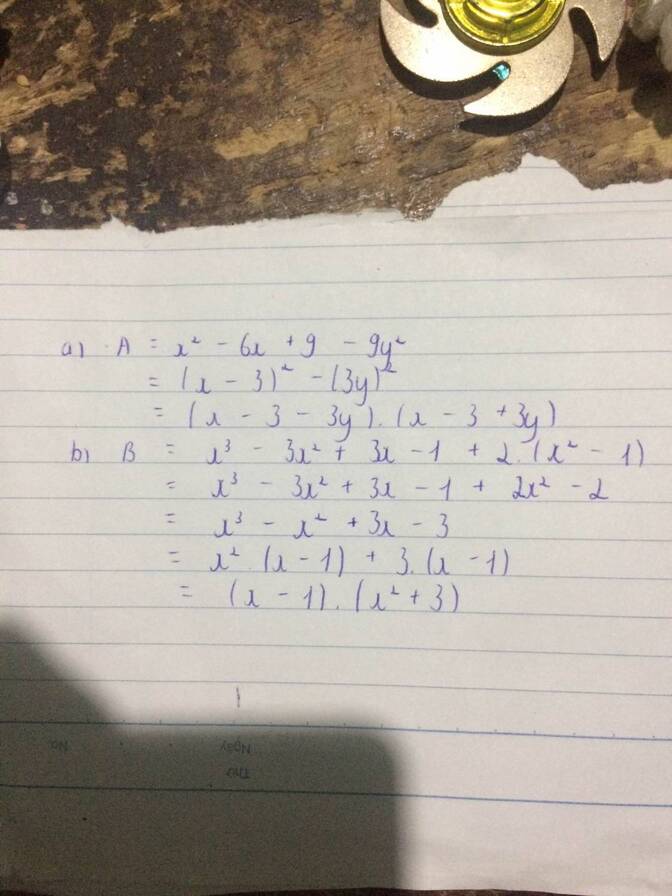Phân tích các đa thức sau thành nhân tử ( a b - 1 ) 2 + ( a + b ) 2
PB
Những câu hỏi liên quan
Phân tích các đa thức sau thành nhân tử x 3 + 2 x 2 + 2 x + 1 ( a b - 1 ) 2 + ( a + b ) 2
Phân tích các đa thức sau thành nhân tử:
a) \(4x^2+81\)
b) \(x^7+x^2+1\)
a) Ta thấy đa thức \(f\left(x\right)=4x^2+81\) vô nghiệm (*).
Giả sử \(f\left(x\right)\) có thể phân tích được thành nhân tử, khi đó \(f\left(x\right)=\left(ax+b\right)\left(cx+d\right)\), suy ra \(f\) có nghiệm là \(x=-\dfrac{b}{a}\) hoặc \(x=-\dfrac{d}{c}\), mâu thuẫn với (*).
Vậy ta không thể phân tích \(f\left(x\right)\) thành nhân tử.
b) \(g\left(x\right)=x^7+x^2+1\)
\(g\left(x\right)=x^7-x+x^2+x+1\)
\(g\left(x\right)=x\left(x^6-1\right)+\left(x^2+x+1\right)\)
\(g\left(x\right)=x\left(x^3-1\right)\left(x^3+1\right)+\left(x^2+x+1\right)\)
\(g\left(x\right)=x\left(x^3+1\right)\left(x-1\right)\left(x^2+x+1\right)+\left(x^2+x+1\right)\)
\(g\left(x\right)=\left(x^2+x+1\right)\left(x^5-x^4+x^2-x+1\right)\)
Xét \(h\left(x\right)=x^5-x^4+x^2-x+1\), nếu \(h\left(x\right)\) phân tích được thành nhân tử thì nó có nghiệm hữu tỉ. Khi đó nó có dạng \(x=\dfrac{p}{q},\left(p,q\inℤ;\left(p,q\right)=1\right),p|1,q|1\) \(\Rightarrow x=\pm1\). Ta thấy \(h\left(1\right).h\left(-1\right)\ne0\) nên 2 nghiệm này không thỏa mãn. Vậy h(x) không có nghiệm hữu tỉ \(\Rightarrow\) g(x) không thể phân tích tiếp.
Đúng 3
Bình luận (0)
a)
\(4x^2+81\\=(2x)^2+2\cdot2x\cdot9+9^2-36x\\=(2x+9)^2-36x\)
Bạn xem lại đề bài nhé!
b)
\(x^7+x^2+1\\=(x^7+x^6+x^5)-x^6-x^5-x^4+(x^4+x^3+x^2)-(x^3-1)\\=x^5(x^2+x+1)-x^4(x^2+x+1)+x^2(x^2+x+1)-(x-1)(x^2+x+1)\\=(x^2+x+1)(x^4-x^4+x^2-x+1)\)
Đúng 0
Bình luận (0)
phân tích các đa thức sau thành nhân tử:
a, A= x2 - 6x + 9 - 9y2
b, B= x3 - 3x2 + 3x - 1 + 2(x2 - 1)
a) \(A=x^2-6x+9-9y^2\)
\(=\left(x-3\right)^2-\left(3y\right)^2\)
\(=\left(x-3-3y\right)\left(x-3+3y\right)\)
b) \(B=x^3-3x^2+3x-1+2\left(x^2-1\right)\)
\(=\left(x-1\right)^3+\left(2x+2\right)\left(x-1\right)\)
\(=\left(x-1\right)\left[\left(x-1\right)^2+2x+2\right]\)
\(=\left(x-1\right).\left(x^2+3\right)\)
Đúng 1
Bình luận (0)
a, \(A=\left(x-3\right)^2-9y^2=\left(x-3-3y\right)\left(x-3+3y\right)\)
b, \(B=\left(x-1\right)^3+2\left(x-1\right)\left(x+1\right)=\left(x-1\right)\left[\left(x-1\right)^2+2\left(x+1\right)\right]\)
\(=\left(x-1\right)\left(x^2-2x+1+2x+2\right)=\left(x-1\right)\left(x^2+3\right)\)
Đúng 0
Bình luận (0)
phân tích các đa thức sau thành nhân tử:
a, A= x2 - 6x + 9 - 9y2
b, B= x3 - 3x2 + 3x - 1 + 2(x2 - 1)
Bài 1. Phân tích các đa thức sau thành nhân tử:
a) 4a2-6b b) m3n-2m2n2-mn
Bài 2.Phân tích các đa thức sau thành nhân tử:
a) 4(2-u)2+uv-2v
b) a(a-b)3-b(b-a)2-b2(a-b)
Bài 1:
a: \(4a^2-6b=2\left(2a^2-3b\right)\)
b: \(m^3n-2m^2n^2-mn\)
\(=mn\left(m^2-2mn-1\right)\)
Đúng 1
Bình luận (0)
Bài 1:
a) \(4a^2-6b=2\left(a^2-3b\right)\)
b) \(=mn\left(m^2-2mn-1\right)\)
Bài 2:
a) \(=4\left(u-2\right)^2+v\left(u-2\right)=\left(u-2\right)\left(4u-8+v\right)\)
b) \(=a\left(a-b\right)^3-b\left(a-b\right)^2-b^2\left(a-b\right)=\left(a-b\right)\left[a\left(a-b\right)^2-b\left(a-b\right)-b^2\right]=\left(a-b\right)\left(a^3-2a^2b+ab^2-ab+b^2-b^2\right)=\left(a-b\right)\left(a^3-2a^2b+ab^2-ab\right)\)
Đúng 1
Bình luận (0)
Phân tích các đa thức sau thành nhân tử;
a) 10x^2 +10xy-x-y
b) 16a^2-1+2b-b^2
a) \(10x^2+10xy-x-y=10x\left(x+y\right)-\left(x+y\right)=\left(x+y\right)\left(10x-1\right)\)
Đúng 1
Bình luận (0)
Bài 1: Phân tích đa thức thành nhân tử a)4(2-x)^2+xy-2y b)3a^2x-3a^2y+abx-abyBài 2: Phân tích đa thức thành nhân tử a)x(x-y)^3-y(y-x)^2-y^2(x-y) b)2ax^3+6ax^2+6ax+18aBài 3: Phân tích đa thức thành nhân tử a)x^2y-xy^2-3x+3y b)3ax^2+3bx^2+bx+5a+5bBài 4: Tính giá trị biểu thức Aa(b+3)-b(3+b) tại a2003 và b1997Bài 5: Tìm x, biếta)8x(x-2017)-2x+40340 b)x^2(x-1)+16(1-x)0
Đọc tiếp
Bài 1: Phân tích đa thức thành nhân tử
a)4(2-x)\(^2\)+xy-2y b)3a\(^2\)x-3a\(^2\)y+abx-aby
Bài 2: Phân tích đa thức thành nhân tử
a)x(x-y)\(^3\)-y(y-x)\(^2\)-y\(^2\)(x-y) b)2ax\(^3\)+6ax\(^2\)+6ax+18a
Bài 3: Phân tích đa thức thành nhân tử
a)x\(^2\)y-xy\(^2\)-3x+3y b)3ax\(^2\)+3bx\(^2\)+bx+5a+5b
Bài 4: Tính giá trị biểu thức
A=a(b+3)-b(3+b) tại a=2003 và b=1997
Bài 5: Tìm x, biết
a)8x(x-2017)-2x+4034=0 b)x\(^2\)(x-1)+16(1-x)=0
\(1,\\ a,=4\left(x-2\right)^2+y\left(x-2\right)=\left(4x-8+y\right)\left(x-2\right)\\ b,=3a^2\left(x-y\right)+ab\left(x-y\right)=a\left(3a+b\right)\left(x-y\right)\\ 2,\\ a,=\left(x-y\right)\left[x\left(x-y\right)^2-y-y^2\right]\\ =\left(x-y\right)\left(x^3-2x^2y+xy^2-y-y^2\right)\\ b,=2ax^2\left(x+3\right)+6a\left(x+3\right)\\ =2a\left(x^2+3\right)\left(x+3\right)\\ 3,\\ a,=xy\left(x-y\right)-3\left(x-y\right)=\left(xy-3\right)\left(x-y\right)\\ b,Sửa:3ax^2+3bx^2+ax+bx+5a+5b\\ =3x^2\left(a+b\right)+x\left(a+b\right)+5\left(a+b\right)\\ =\left(3x^2+x+5\right)\left(a+b\right)\\ 4,\\ A=\left(b+3\right)\left(a-b\right)\\ A=\left(1997+3\right)\left(2003-1997\right)=2000\cdot6=12000\\ 5,\\ a,\Leftrightarrow\left(x-2017\right)\left(8x-2\right)=0\\ \Leftrightarrow\left[{}\begin{matrix}x=2017\\x=\dfrac{1}{4}\end{matrix}\right.\\ b,\Leftrightarrow\left(x-1\right)\left(x^2-16\right)=0\Leftrightarrow\left[{}\begin{matrix}x=1\\x=4\\x=-4\end{matrix}\right.\)
Đúng 2
Bình luận (0)
Lol .ngudoots
Phân tích các đa thức sau thành phân tử pp đặt nhân tử chung 2ab^2 - a^2b - b^3
\(2ab^2-a^2b-b^3=b^2\left(2a-a^2-b\right)\)
Đúng 4
Bình luận (0)
\(2ab^2-a^2b-b^3\)
\(=-b\left(a^2-2ab+b^2\right)\)
\(=-b\left(a-b\right)^2\)
Đúng 1
Bình luận (0)
-(2ab2 - a2b - b3)
= b(-2ab + a2 + b2)
= b(a2 - 2ab + b2)
= b(a - b)2
Đúng 1
Bình luận (1)
Bài 1 : Phân tích các đa thức sau thành nhân tử :1) 15x + 15y 2) 8x - 12y3) xy - x 4) 4x^2- 6xBài 2 : Phân tích các đa thức sau thành nhân tử :1) 2(x + y) - 5a(x + y) 2) a^2(x - 5) - 3(x - 5)3) 4x(a - b) + 6xy(a - b) 4) 3x(x - 1) + 5(x -1)Bài 3 : Tính giá trị của biểu thức :1) A 13.87 + 13.12 + 132) B (x - 3).2x + (x - 3).y tại x 13 và y 4Bài 4 : Tìm x :1) x(x - 5) - 2(x - 5) 0 2) 3x(x - 4) - x + 4 03) x(x - 7) -...
Đọc tiếp
Bài 1 : Phân tích các đa thức sau thành nhân tử :
1) 15x + 15y 2) 8x - 12y
3) xy - x 4) 4x^2- 6x
Bài 2 : Phân tích các đa thức sau thành nhân tử :
1) 2(x + y) - 5a(x + y) 2) a^2(x - 5) - 3(x - 5)
3) 4x(a - b) + 6xy(a - b) 4) 3x(x - 1) + 5(x -1)
Bài 3 : Tính giá trị của biểu thức :
1) A = 13.87 + 13.12 + 13
2) B = (x - 3).2x + (x - 3).y tại x = 13 và y = 4
Bài 4 : Tìm x :
1) x(x - 5) - 2(x - 5) = 0 2) 3x(x - 4) - x + 4 = 0
3) x(x - 7) - 2(7 - x) = 0 4) 2x(2x + 3) - 2x - 3 = 0
\(1,\\ 1,=15\left(x+y\right)\\ 2,=4\left(2x-3y\right)\\ 3,=x\left(y-1\right)\\ 4,=2x\left(2x-3\right)\\ 2,\\ 1,=\left(x+y\right)\left(2-5a\right)\\ 2,=\left(x-5\right)\left(a^2-3\right)\\ 3,=\left(a-b\right)\left(4x+6xy\right)=2x\left(2+3y\right)\left(a-b\right)\\ 4,=\left(x-1\right)\left(3x+5\right)\\ 3,\\ A=13\left(87+12+1\right)=13\cdot100=1300\\ B=\left(x-3\right)\left(2x+y\right)=\left(13-3\right)\left(26+4\right)=10\cdot30=300\\ 4,\\ 1,\Rightarrow\left(x-5\right)\left(x-2\right)=0\Rightarrow\left[{}\begin{matrix}x=2\\x=5\end{matrix}\right.\\ 2,\Rightarrow\left(x-7\right)\left(x+2\right)=0\Rightarrow\left[{}\begin{matrix}x=7\\x=-2\end{matrix}\right.\\ 3,\Rightarrow\left(3x-1\right)\left(x-4\right)=0\Rightarrow\left[{}\begin{matrix}x=\dfrac{1}{3}\\x=4\end{matrix}\right.\\ 4,\Rightarrow\left(2x+3\right)\left(2x-1\right)=0\\ \Rightarrow\left[{}\begin{matrix}x=-\dfrac{3}{2}\\x=\dfrac{1}{2}\end{matrix}\right.\)
Đúng 4
Bình luận (0)










